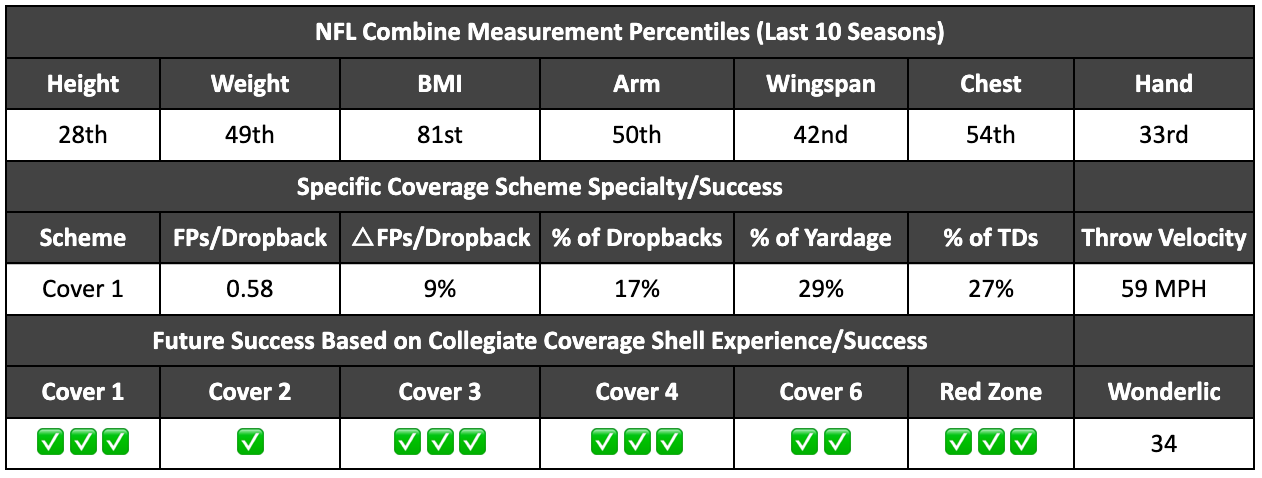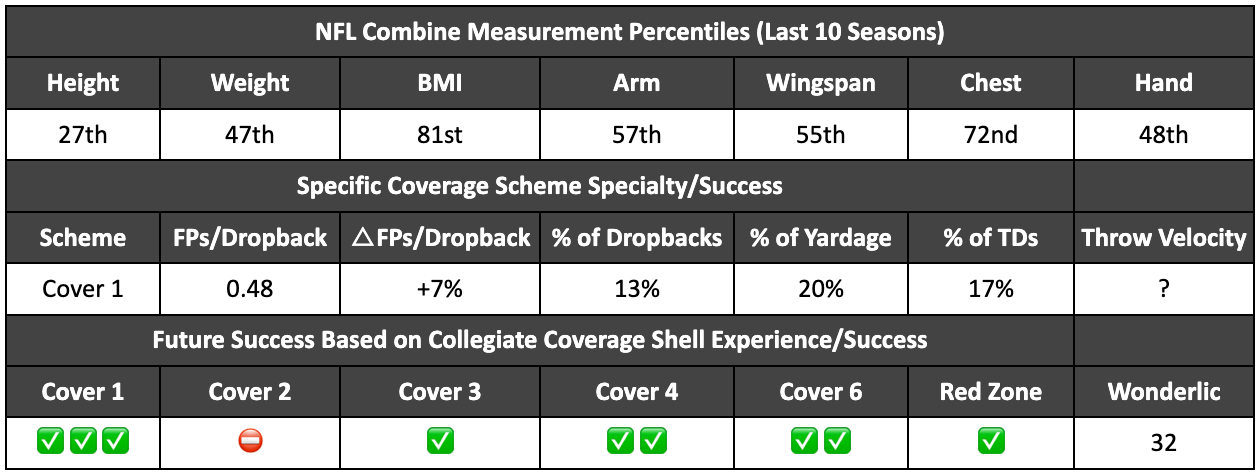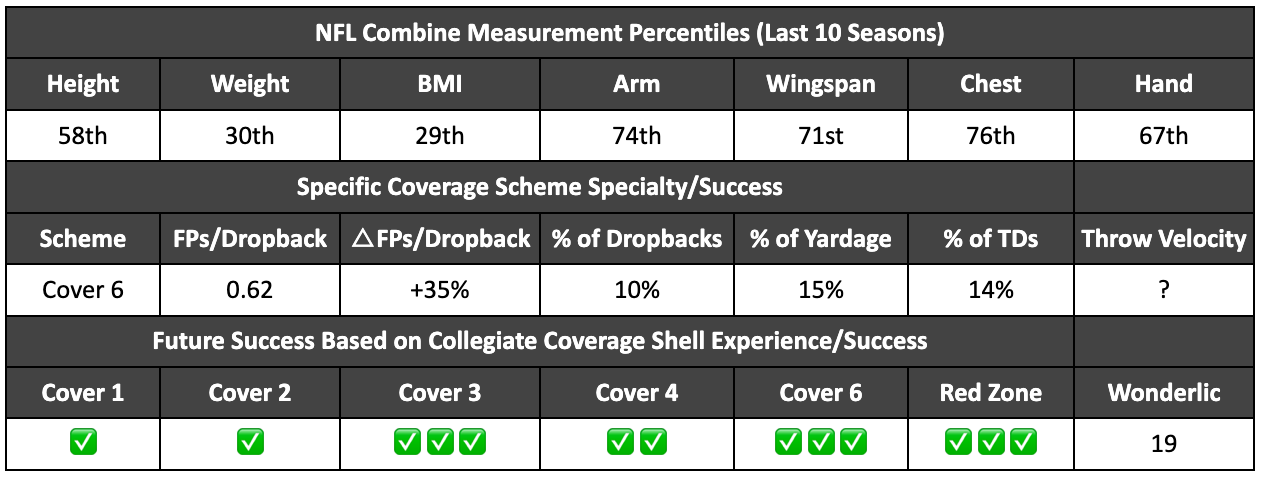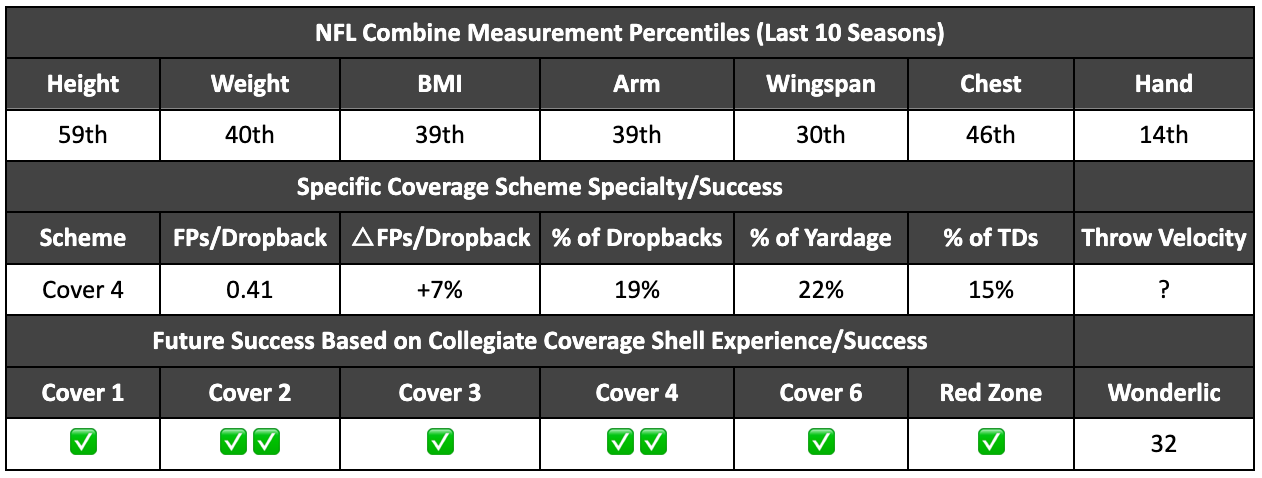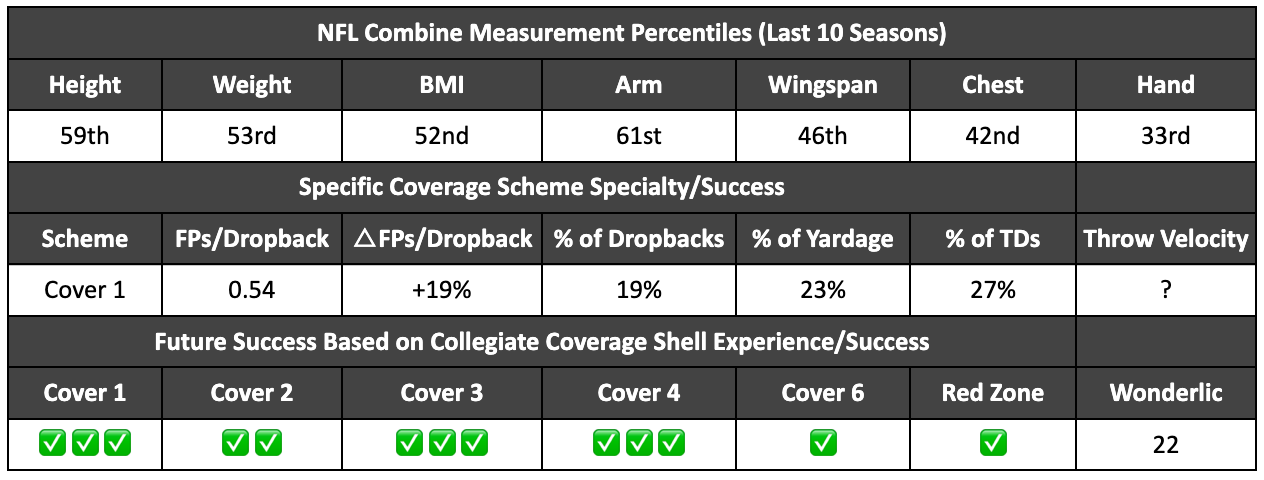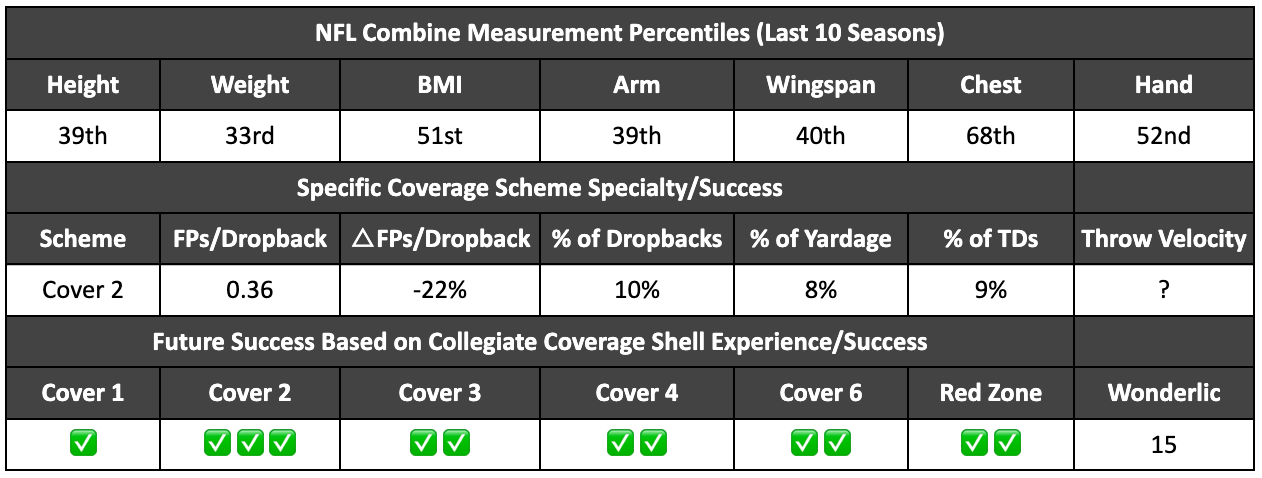| Class Rank | Player | College | DOB | Age (Week 1) |
| QB1 | Sam Howell | North Carolina | 9/16/00 | 21.11 |
| QB2 | Malik Willis | Liberty | 5/25/99 | 23.3 |
| QB3 | Desmond Ridder | Cincinnati | 8/31/99 | 23.0 |
| QB4 | Kenny Pickett | Pittsburgh | 6/6/98 | 24.3 |
| QB5 | Carson Strong | Nevada | 9/14/99 | 22.11 |
| QB6 | Matt Corral | Ole Miss | 1/31/99 | 23.7 |
| QB7 | Bailey Zappe | Western Kentucky | 4/26/99 | 23.4 |
| QB8 | Cole Kelley | Southeastern Louisiana | 8/27/98 | 24.0 |
| QB9 | Dustin Crum | Kent State | 1/5/99 | 23.8 |
| QB10 | Jack Coan | Notre Dame | 12/9/98 | 23.9 |
Sam Howell | 6-foot-0 ⅝” | 224 lbs. | North Carolina Tar Heels
Sam Howell ended his UNC career with the most passing TDs after three seasons (92), second-most passing YPG (277.9) and second-highest passing efficiency (164.2) in ACC history. In only three seasons, Sam set the career standards for the Tar Heels in passing yards (10,283), YPA average (9.17), passing TDs, total TDs (111) and total yardage (11,292). During his three bowl games, Howell completed 64.7% of his attempts, an 8.62 YPA average and seven TDs vs. one INT. In career games against, arguably, the three top defenses in the ACC (Clemson, NC State and Notre Dame – I know the Irish are an Independent, I’m including them anyway), Howell threw nine TDs vs. three INTs.
Looking for an early-age breakout? Howell not only set the FBS true freshman record for passing TDs (38), it was also the third-most in a single season by any QB in the ACC and ranked fourth-most in the country that season. He also ranked 14th-best in the country in passing yards (3,641) and with the 10th-highest passing efficiency (160.3). He connected for at least two TDs in 13 straight games, eight with at least three. Did I fail to mention he accomplished all of that during his Age 18 season?
Ready for the Encore
— All-American Bowl (@AABonNBC) May 17, 2020
During his freshman campaign 2019 All-American Sam Howell (@Sam_Howell2) threw for 3,641 yards and 38 touchdowns which were both Tar Heel records.#AllAmericanBowl 🇺🇸#CarolinaFootball pic.twitter.com/lo6Dj1Hi3p
In spite of a level of surface success that encircles that of any QB in the class, Howell will enter the ‘22 draft well under the radar. First order of business, it is a massive mistake to discount the ‘21 impact played in having three of the four wideouts (Beau Corrales, Khafre Brown and Emery Simmons) transfer out that were expected to assist in the team’s transition away from losing Dyami Brown, Dazz Newsome, Javonte Williams, and Michael Carter to the NFL. Howell would be left with two WRs (Josh Downs and Antoine Green) with all of 23 career receptions to distribute 83% of his ‘21 completions to the position.
Setting up a similar scenario, consider the 2013 season for Tom Brady. Rob Gronkowski was slowed by his infamous forearm infection before being lost to ACL and MCL tears, Aaron Hernandez was arrested, Wes Welker (Broncos) and Danny Woodhead (Chargers) signed elsewhere and Brandon Lloyd was released to save money. The Patriots would play the season with Danny Amendola, Aaron Dobson, Josh Boyce, and Kenbrell Thompkins as Brady’s “threats” at receiver. What resulted was the second-lowest completion percentage (60.5%), fourth-lowest passer rating (87.3) and YPA average (6.92) of The GOAT’s career – most of the inferior examples came early in his career. New England’s ‘13 playoff run ended with the only examples from Brady’s storied career where he failed to pass for at least 500 total yards or two TDs when playing more than one playoff game.
Should direct comparisons be made between The GOAT and Howell? That answer should be obvious. It’s simply an exercise in futility to account for a drop-off in efficiency for even the very best we’ve ever seen when the surrounding cast is undermined. Howell’s completion rate (-9.5%), YPA average (-15.2%), passing TD rate (-20.9%) and passer rating (-16.6%) each declined from the 2020 to ‘21 season.
How did Howell respond to the knowledge that his passing efficiency was under attack? His air yardage/attempt (AY/Att) went up! He never pulled that foot off the gas due to his surrounding cast. Sam also flipped the script during that true junior season to rush for 1,110 yards – sack yardage removed, 11 TDs, shed 71 tackle attempts and averaged 4.91 yards after contact/carry. He averaged 92.5 rushing YPG and 0.92 TDs/game that accounted for 14.7 of his 32.1 FPG total (45.8%).
With a consensus reputation as a future first-rounder after a big ‘20 season, Howell still put his body on the line with his legs to do whatever he could to assist his team. And that rushing success is far from an anomaly. During his career at Sun Valley High School, Howell accounted for the third-most career total TDs (213 – 59 on the ground) and the most total yardage (16,815 – 3,460 collected with his legs) in North Carolina HS history.
During his three seasons in Chapel Hill, Howell led the ‘22 QB class in FPs/dropback (FP/Db), YPA average, AY/Att and passer rating across from Cover 1. He is one of only three in the class to post an increase in passer rating against Cover 1, also adding a 16% spike to his YPA and 18% to his AY/Att. But his passing success extended onto another plane from any type of reputation as a one-trick pony. Howell is the only QB in the class to rank inside the top-5 in FP/Db against four of the five most common coverage schemes. And he generated four TD throws for each INT during his career.
Combine Highlights
Howell is at the head of the class in regard to his vertical passing success. He accounted for the third-most completions and the most TDs at a depth of at least 20 air yards. Sam also registered the most completions and the most TD throws of at least 30 air yards. And he finishes off the trifecta with the most completions and the most TD throws of at least 40 air yards. Consider that his “down” ‘21 season included pacing the class with 11.9 AY/Att. He averaged more than one AY/Att than Desmond Ridder and two more than Kenny Pickett, Carson Strong, Matt Corral and Bailey Zappe. And he led each of the QBs detailed in this piece with his 8.72 YPA average last season. That’s all in addition to breaking 17 more tackles on rushing attempts than Ridder, Pickett, Corral, Strong and Zappe, combined.
Throughout his North Carolina career, Howell was nothing short of a red zone phenomenon. In only three seasons, he connected on the most throws inside the 20, while hooking his receivers up with 18 TDs vs. a single INT. It’s just not a stretch to state that Howell put up FCS- or G5-like numbers in a P5 conference. We were only provided with the Combine results from the three QBs finishing at the top, but we know Howell’s throw velocity (59 MPH) is not only the fastest – by at least seven MPH over all QBs sans Dustin Crum and Jack Coan – in the ‘21 class, it’s the fourth-fastest recorded from the last 10 seasons at the Combine. Josh Allen provided the fastest ball velocity in 2018 at 62 MPH.
At the end of the day, it’s very important to consider the source when leaving your evaluation of this QB class to others. Any rumors of a team's specific interest in one individual – particularly franchises drafting outside of the first five selections – can be entirely disregarded. It really applies to all positions but, if there’s one position that teams will attach their interest directly to their chest, it’s at QB. “Anonymous” executives and scouts are the main ingredients comprising the rumor mill.
Quarterbacks with the most big time throws since 2019
— PFF Draft (@PFF_College) April 2, 2022
🎯 Sam Howell: 83
🎯 Kenny Pickett: 54
🎯 Sam Hartman: 53 pic.twitter.com/eNvFG6R1Vs
If you’re trusting in one-or-more fantasy analysts to decide, you can confidently extract either personal bias or reliance on the rumor mill directly from their rankings. If they have any QB at the top of their rankings other than Howell and Malik Willis, you instantly know they are likely either relying on outside sources for their evaluation or, dare I say, on a personal bias. Let’s keep our eyes on the prize here — the goal in drafting dyno QBs is in maximizing fantasy scoring potential, not in guessing which one will be drafted first. The general track record for NFL teams drafting QBs is not what anyone would refer to as successful.
The fantasy data is overwhelmingly in favor of Howell and Willis as the best in class. In addition to their impressive passing résumés, they have also established themselves as the most dangerous dual-threat QBs in the class. Before we delve too far into those takeaways for Willis, let’s dig into his profile.
Malik Willis | 6-foot-0 ½” | 223 lbs. | Liberty Flames
Whatever took place in Auburn, Alabama during Malik Willis’ early collegiate career with the Tigers is inconsequential as long as we have spotless offifield reports since. We do. Look no further than Willis being awarded with the ‘21 Bobby Bowden Trophy which is presented to the player that “epitomizes a student-athlete of faith and conducts himself as an exemplary model in the classroom, on the field, on the campus and in the community.” Moving on, Willis took home the Dudley Award, was a finalist for the Johnny Unitas Golden Arm Award and semifinalist for the Davey O’Brien Award and Maxwell Award after throwing for 2,857 yards, 27 TDs and rushing for an additional 1,217 yards – sack yardage excluded – and 13 TDs last season.
Willis’ 27 TD passes from last season are the third-most in program history. He also tied the single-game school mark with six TD strikes against Southern Miss in Week 8 of the ‘20 season. His ‘21 success reset the Liberty standard for total yardage in a single season (3,735 – sack yardage included). Speaking of sack yardage, Willis actually broke the Liberty career record for the most 100-plus-yard rushing games when that yardage is negated. He created the 11th such instance in only two seasons with the Flames after rushing for 124 yards against Ole Miss in Week 10. And he holds first- and second-place in school history for the most total TDs in one season (40 in ‘21 and 37 in ‘20).
Malik Willis had 13 Big-Time Throws against the blitz in 2021...
— PFF Draft (@PFF_College) April 17, 2022
Most by an FBS QB 🎯pic.twitter.com/04Axo7d2oL
Like Howell, Willis took a shine toward overwhelming defenses brave enough to place Cover 1 on the field against him. It’s when he manufactured the third-highest passer rating, the fifth-most FP/Db and his YPA average spiked by a healthy 15%. Malik had considerable issues with Cover 2, when his FP/Db fell by 65%. He also has a bit of work to do when facing Cover 3 after accounting for only five TDs vs. three INTs during his two seasons in Lynchburg.
A profile on Willis would be far from complete without detailing his uber-elite rushing package. Keeping the statistical gauge set to 21st-century standards – aka removing sack yardage, Willis created back-to-back seasons with 1,000 rushing yards and at least 13 TDs. He averaged an eye-opening 99.2 YPG, 1.1 TDs/game and a class-leading 17.0 FPG on the ground alone. Willis also reduced his ‘20 fumble number from 18 to only allowing three to touch the ground last season. And he really hit the ground running during his ‘21 campaign, averaging a class-leading 5.35 yards after contact/carry and eluding 94 tackles – far more than his number of designed carries.
.@LibertyFootball QB @malikwillis crushed his Combine workout. 💪
— NFL (@NFL) March 4, 2022
This dude's got an ARM.
📺: #NFLCombine starting at 4pm ET on @NFLNetwork pic.twitter.com/LOSpaf1B5M
Willis made up for the developing areas in his aerial game with very promising results against Cover 4 and 6. He was also responsible for the second-most AY/Att last season (11.4). Willis does have some minor short-to-intermediate accuracy concerns, but the young man can rocket the ball out of the stadium. As far as arm strength is concerned, short of dipping into unknown commodities out of the FCS (Cole Kelley), this QB class boils down to Howell, Willis and Carson Strong. Breaking that down to also include dual-threat leggings, Howell and Willis are on an island by themselves. The closest asset we have to visiting that island is the name we’ll discuss next.
Desmond Ridder | 6-foot-3 ⅜” | 213 lbs. | Cincinnati Bearcats
Composure. Leadership. Consistency. These are the types of traits that allowed Desmond Ridder to pick up steam during the evaluation process. Ridder collected 44 wins during his UC career – third-most in college football history. Desmond put together an impressive collection of almost awards, honored as a finalist for the 2021 Johnny Unitas Golden Arm Award and a semifinalist for the Maxwell Award, Davey O’Brien Award and Walter Camp Player of the Year Award. He also set his school’s record for career TD passes (87), total yardage (12,418) and rushing TDs by a QB (28).
Ridder was a zone specialist during his Bearcats’ career. He ranks inside the top-seven in this class across from Cover 3, 4 and 6. He saved his best for the Cover 2 and 4 mashed combination that stands as the basis for the Cover 6 scheme. He posted the third-most FP/Db (0.62) against Cover 6 – a 35% increase above his overall average and a number that topped the class. He also led the QB class with a 32% spike to his YPA vs. Cover 6. And he finished with the second-highest passer rating (125.2) against Cover 6 after tossing 12 TDs vs. zero INTs.
Check out the Ridder Resume. 👀📝@GoBearcatsFB
It was a red zone bonanza during Ridder’s days in Cincinnati. Desmond topped the class with 1.49 FP/Db when working inside the 20. His 19 TDs against a single red zone INT speaks to his unrelenting composure when opportunities to scoreboard points are within range. As alluded to earlier, Ridder also dealt out a dual-threat component to his game, averaging 56.1 YPG – sack yardage removed, 0.72 TDs/game and 9.9 FPG.
One of the Combine percentiles inside the table above that we want to focus our attention toward is Ridder’s 29th-percentile BMI. In order for Ridder to provide us with the ground upside that’s essential to becoming a top-flight fantasy QB, we need him to actually survive the ordeal. Yes, his 4.52 second 40-time will certainly serve him well, but we’re dipping into rarified territory with a 26.43 BMI. At that level of BMI, we’re discussing the body thickness dominion of a Daniel Jones or Jared Goff. We all know Goff is not a threat on the ground, while Danny Dimes has taken quite a beating during his career with damage to his ankles, a concussion and the neck injury that ended his ‘21 season.
Combine Highlights
We have plenty of footage showcasing Ridder with an arm that deserves an opportunity to lead an NFL offense. He’ll certainly be a threat to scramble away from pressure for a certain level of rushing production, but he is not a candidate at the goal line and considerable dyno capital investments will be undertaking a considerable risk on Desmond’s future team pushing him into a decent rate of designed runs.
Kenny Pickett | 6-foot-3 ⅜” | 219 lbs. | Pittsburgh Panthers
Would you like to learn the approach toward scouting QBs for NFL success? The initial 80% of the process is easy enough, as long as you know what factors where the attention should be focused. We want to see considerable, rock-solid consistency in at least the QBs final season. If the signal caller is missing an arm cannon, all is not lost. Airtight accuracy and dominant ground production are worthy of attention. In a perfect world, arm cannon +plus+ pinpoint accuracy +plus+ sexy leg production is the goal.
When we find one checking each of those three boxes, we dig into the profile history of coverage success – signs of a breakout should already be in place if it’s one of the final-season QBs. The optimal profile showcases a command of Cover 1 and Cover 3. Success across from the remaining zone setups can be satisfactory but, if lacking Cover 1 and 3 distinction, we would need the individual to excel across from all three.
It is possible that a QB could transcend posting average collegiate production, minimal stats on the ground and failure to dominate more than one scheme? ANYTHING is possible in the world of QBs – see Kurt Warner or Grayson McCall. Which brings us to the final 20% of the eval. For the first dime of the percentage, you’ll spend whatever time you have available searching through the tape to find any flaws in leadership, pre-snap reads, footwork, setting protections, rhythm, pocket management, release mechanics, anticipation, ball placement, mode of transportation preference, scrutiny of his choices in ladies, favorite color, etc. More than anything, this stage in the process is focused on sifting through the weeds.
After you’re satisfied he passes the eye test of the factors you deem to be valuable, the scout takes his favorite coin from his pocket and flips it. That flip comprises the final 10% of the QB evaluation process. And it’s a process that NFL teams have provided extensive evidence toward not being very successful. It’s considered a great draft if more than two impact QBs are plucked from the crop.
Combine Highlights
As dynasty owners, we have the luxury of being extremely picky with our QB selections. Since Kenny Pickett is somehow floating about as the favorite flavor of the scouting consensus, you can just read his background profile elsewhere. The pertinent take-home is that Pickett has struggled through a career of mediocrity. His poor play dates back to his 2016 senior year in HS where he completed less than 60% of his attempts. During his first four years on Pittsburgh’s campus: 39 TDs vs. 25 INTs.
As already passed along, a QB can plead the final-year rule, which Pickett is taking to the bank after his 42 TDs vs. seven INTs last season. Overall, Pickett ranks outside of the top-10 in the class in FP/Db against each of the five-most common coverage schemes (Cover 1, 2, 3, 4 and 6). He was slightly better when facing split-safety schemes (Cover 2 and 4), but struggled in Cover 6 pre-snap recognition.
He improved against Cover 1 during his big ‘21 season, closing out his Panthers’ career with five TDs vs. one INT. He had barely completed 50% of attempts, accounted for a mere 5.5 YPA and a 71.3 passer rating across from single coverage prior to last season. He bumped those numbers to 60%, 8.1 and 98.2 last season.
Kenny Pickett had 25 TDs against the blitz in 2021...
— PFF Draft (@PFF_College) April 10, 2022
Most in a season by a P5 QB since 2014 🎯 pic.twitter.com/oVjSXZzNOr
Kenny was steady on the ground, averaging 5.3 FPG over his last four seasons. But steady is a far cry from dominant. Pickett is not going to help our squads much on the ground. He’s only slightly thicker than Ridder and significantly slower. That’s a massive knock on his upside. In addition, he does not have an arm cannon – don’t allow anyone to tell you differently. Pickett has developed into an accuracy-based QB.
If everything, I mean everything comes together for him, his steady ground number and a big TD year will provide him with one big season in the pros, two tops. We can’t use that coin flip trick for the final 10% of Pickett’s eval. No vertical game and no sexy legs. Head to your local casino, place that draft capital on No. 8 and roll the dice. Those are your odds for a top-10 fantasy season from Pickett.
Carson Strong | 6-foot-3 ⅜” | 226 lbs. | Nevada Wolfpack
The analysis of a Group of Five QB always takes on an additional layer of difficulty. In no less than 95% of those evals, they prove to be unworthy of our time. It’s quite a bit of a surprise from such a limited QB class that we have two G5 QBs that are entirely worth our time to evaluate: Willis (duh) and Carson Strong. Before anyone waste’s their breath, Liberty is technically an independent program but, if you play a G5 schedule, you’re a G5 program. Buck up that schedule difficulty if you want to be considered amongst the big boys.
We can add Strong as the 1C complement to Howell and Willis in the arm cannon category. Chew on this for a bit: Strong connected on the most career completions and the most TDs of at least 50 air yards in this class. At least five starting QBs in the NFL could be pointed out that would struggle to throw a ball 50 yards downfield, let alone with any type of accuracy. After Howell (four schemes), Strong is the only QB in the class to rank inside the top-five in FP/Db against at least three of the five most common coverage schemes they’ll face in the NFL.
Carson Strong 🤝 Mountain West Offensive Player of the Year
— Nevada Football (@NevadaFootball) November 30, 2021
Back-to-Back#BattleBorn // #NevadaGrit pic.twitter.com/kT6jc4UWPJ
The comparisons to Howell’s arm talent don’t end there, as Strong also shredded Cover 1 defenses. He created 0.54 FP/Db across from single-high, the second-most in the class and a 19% jump above his overall average – a number that led the class. Carson also paced the class with his 27% increase in AY/Att when facing Cover 1. He closed out the single-coverage dominance factory with 20 TDs vs. three INTs and the third-highest passer rating. Never discount Cover 1 success, direct utility exists alongside a decent level of NFL ascendancy on that singular platform.
Let’s deflate the hype balloon before we go any further. Strong will not provide us with anything on the ground. If he can set his protections and get those legs to capably manipulate pressure, it should be considered as an accomplishment. One unchecked box from the big three isn’t going to sink Strong’s fantasy potential, but it certainly caps his upside. At this point, we know Strong has the cannon, excelled against both Cover 1 and 3 and that his legs are not sexy.
Nevada’s Carson Strong had the throw of the NFL Combine yesterday, this 55-yard bomb to Ohio State’s Chris Olave. Read about how Strong, Romeo Doubs and Cole Turner fared at the Combine here: https://t.co/mO7x2sVeFRpic.twitter.com/X7QhRMYl3Z
— Nevada Sports Net (@NevadaSportsNet) March 4, 2022
Dating all the way back to his sophomore year at Wood High School, Carson has never posted a completion percentage below 63.4%. Over his last five seasons of ball, Strong has completed 68.5% of his throws (1075/1570) and, just for fun, 105 TDs vs. 23 INTs. When a QB is consistently throwing the ball at depths similar to Strong, a near 70% rate of completion transcends the opposition’s talent level. And Carson has a wildcard up his sleeve in averaging 18.1 PPG, 12.8 RPG and 2.8 APG during his junior year at Wood HS on the hardcourt, speaking to his unappreciated footwork.
If you’ve yet to watch the Combine footage of Strong consistently landing bombs traveling 50 air yards on receivers, the only video I was able to find is within the tweet above. Strong is going to be overlooked until the consensus “top-five” QBs are off the board in Superflex formats. That’s prime real estate for value. I’ll surrender the likelihood that Pickett’s higher anticipated draft slot ends up providing him with a longer leash and an earlier opportunity for starts. That said, Strong’s arm talent is superior to everyone in the class, sans Howell and Willis.
Matt Corral | 6-foot-1 ⅝” | 215 lbs. | North Carolina Tar Heels
This QB class is essentially constructed from five QBs. Since the belief that Strong is among that group has already been outlined, something needs to give with six QBs profiled. No need to beat around the bush, Matt Corral is not among the top QBs in the class. Allow me to get the first level of that reasoning out of the way, I’m simply unable to eliminate a personal bias in the case of Corral. During Week 7 of Matt’s ‘20 season, he threw six INTs in a single game at Arkansas. The memory of that “performance” has never left me.
There’s no denying that Corral had a late career revival. After Matt Luke was replaced by Lane Kiffin following the 2019 season, Corral was thrust into the spotlight. During the previous ‘19 season, Corral split QB duties with rushing wizard John Rhys Plumlee. Over the last two seasons since emerging as the starter, Corral threw for at least 3,300 yards and connected on 86% of his career TDs passes.
Matt Corral among SEC QBs since 2020:
— PFF Draft (@PFF_College) April 25, 2022
🥇 6,691 passing yards (1st)
🥇 49 pass TDs (1st)
🥇 41 Big Time Throws (1st)pic.twitter.com/oWZqQMOM2z
The most compelling trait in favor of Corral is found in his consistency since taking over the offense. He ranks inside the top-10 in the QB class in FP/Db against four of the five most common coverage schemes, as well as inside the red zone. But Corral’s specialty is his work submitted against Cover 2. He’s generated the fourth-most FP/Db (0.36) that’s fueled by the third-highest passer rating.
You might notice the -22% decrease in FP/Db from his overall average; the attached fourth-best rank articulates the general struggles from young QBs when facing that particular scheme. Corral is another in the class that has excelled inside the red zone. His 16 TDs across from two INTs is quite impressive. And Corral has established a consistent ground game over his final two seasons with 59.2 YPG – sack yardage removed, 0.65 TDs/game and 9.8 FPG by way of his legs.
Just when it seemed that Corral had overcome his INT-mania, he ended the season with three TDs vs. three INTs. Let’s not forget that, five games after throwing those six INTs at Arkansas, Corral threw another four INTs at LSU in the second-to-last game of the ‘20 season. When you’ve fumbled 23 times in your last 33 games, adding 21 INTs is not going to be a boon to ticket sales. It’s never a great idea to place immense faith into the Wonderlic. It just doesn’t scream processing trust when you record the second-lowest score from the last 10 Combines. With zero trust in his ability to protect the ball, no skill player projected to be drafted within the first two rounds comes anywhere close to the bust potential present for Corral.


